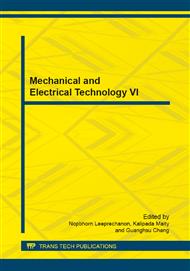p.214
p.219
p.224
p.230
p.236
p.242
p.249
p.254
p.261
The Performance of a Delta Telerobot
Abstract:
The paper investigates the performance of a delta telerobot that a human operator works on a given task through the eye and hand of the robot. The Delta robot is installed with eye in hand camera and controlled by an open architecture controller that is configured to control the robot to follow the motion of the selectable HMI devices. The evaluation task is a three dimensional “connect the dot” game in which the robot is tele-operated with visual feedback to go point to point from position 1 to 6. The task performance is used to evaluate the performance of the total system that involves a robot, human factors, HMI, and environment. Three HMI devices including a manual pulse generator, Kinect camera, and a PHANToM OMNI Haptic Device are benchmarked. The result demonstrates that the Haptic with guided force is the best when compared to the others. In addition, the telerobot system can improve the time to completion by 30% and positioning accuracy by 50%, compared to human in the human scaled task. Then we investigate the effect of time delay of the delta telerobot with the Haptic. The result demonstrates that the time delay, that exceeds 100 ms, is proportion to both time to completion and positioning error in telerobot task, while the time delay below 100 ms gives no effect.
Info:
Periodical:
Pages:
236-241
Citation:
Online since:
August 2014
Authors:
Keywords:
Price:
Сopyright:
© 2014 Trans Tech Publications Ltd. All Rights Reserved
Share:
Citation:


